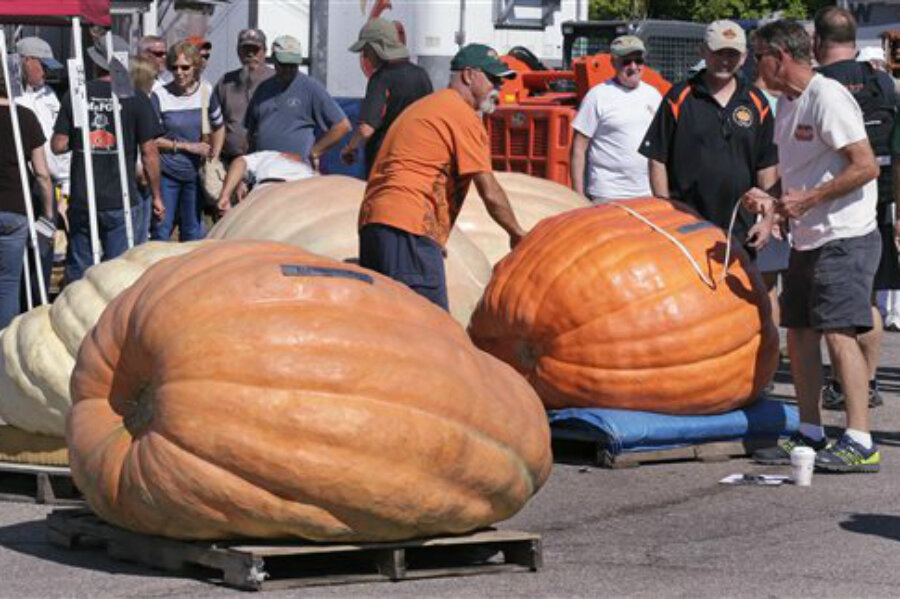Growing a 2,000-pound pumpkin is as hard as it sounds
Loading...
| Coventry, R.I.
Ron Wallace grows pumpkins nearly the size of a Fiat.
From the pumpkin patch in his Rhode Island backyard, Wallace has become the rock star of giant pumpkin-growing. He was the first person in the world to break the 2,000-pound, or 1-ton, barrier when he grew a 2,009-pound pumpkin in 2012, and he previously broke the world record in 2006. A friend calls him a "mainstreamer," someone whose passion for the hobby has spread word to the broader public.
Wallace, a country club manager, has spent 27 years at it, swapping ideas with growers worldwide. About 30,000 people grow giant fruits and vegetables competitively, and pumpkins are most popular, said Andy Wolf, president of the Great Pumpkin Commonwealth, which he calls "the NFL of pumpkin-growing."
"All walks of life. Doctors, lawyers, farmers," Wallace says. "The bond is giant pumpkins."
It all starts with the seed. Top growers know their pumpkins' lineage back generations, and the Great Pumpkin Commonwealth keeps records.
Seeds from Wallace's 2,009-pound pumpkin have sold for more than $1,000 in a charity auction. Wallace has seen counterfeits sold on eBay. Still, many growers freely swap seeds with each other or lobby top growers to use a seed they think is promising.
Like most serious growers, Wallace ties plants' blossoms closed and hand-pollinates them so he can be sure of the mother (the seed) and the father (the pollinator) and protect them from bees carrying pollen from a neighbor's squash.
The vines can grow 1 foot or more daily, and pumpkins can put on 45 pounds per day, mostly from water. The best pumpkins every year follow the weather. If conditions were right in the Ohio Valley, growers there might see a string of hugepumpkins. When there's a drought, as in California, don't expect a bumper crop.
Standing in Wallace's fields, a person feels smaller. Around the edges where he grows flowers and vegetables, his sunflowers have reached 18 feet. A tomato plant produced a 5-pound tomato. Wallace has spent more than two decades painstakingly researching soil science and experimenting. This year, he launched a product based on his growing program, Wallace Organic Wonder. It includes among its ingredients mycorrhizal fungi. He calls it a super-fungus that helps deliver water and nutrients.
"For growers who are competitive, it's year-round. They're studying, they're researching, they're building greenhouses, they're looking at genetics," Wallace said. "Most competitive giant pumpkin growers aren't taking summer vacations."
Wallace, who's single, works up to 40 hours a week on his hobby, checking for mice and disease and burying vines, keeping pumpkins covered in sheets to protect the skin.
Most growers end up spending hundreds or thousands of dollars per year. If they're lucky, they can sell what they grow for a holiday display for $1 a pound, maybe more for a state record, but they say they rarely make money or break even.
One place these pumpkins won't end up: pumpkin pie. They're too big to be tasty.
Many growers branch out. Wallace's friend Joe Jutras, of Scituate, is a 2007 pumpkin world record holder. Now, he's going for the trifecta: world records for heaviest pumpkin (check), longest long gourd (check) and heaviest squash (still working on it after a squash that was on track to break the record split).
The weigh-off is the moment of truth. Crews check for holes, cracks and rot, which would disqualify the entry, before putting it on the scale.
"You can do anything. You can tinker with professional plant hormones or whatever fertilizer you think's going to give you an advantage," Wolf said. "The only thing you can't do is somehow doctor the actual fruit."
Wallace took the biggest pumpkin he grew this season to a weigh-off in Warren on Oct. 10. He won top prize weeks earlier at the Rochester Fair in New Hampshire, with a 1,975-pound gourd. A greenhouse grower in Switzerland holds the world record: 2,323 pounds, grown from a Wallace seed.
Wallace estimates disease cost his Warren pumpkin as much as 150 pounds, and he was wary before the weigh-in.
"I really ratcheted up with water this year," he said.
The result was a victory: 2,230 pounds, a new North American record. It's the second-biggest pumpkin ever grown and the largest grown worldwide this year.
It's closer than Wallace has ever been to 2,500 pounds, the next pumpkin-growing milestone.
"I do feel I'm on the edge. I know my program is capable," he says, as he sketches out plans for next year. "We're gonna give it a shot."
Associated Press writer Rodrique Ngowi in Warren and photographer Charles Krupa in Rochester, New Hampshire, contributed to this report.
Copyright 2015 The Associated Press. All rights reserved. This material may not be published, broadcast, rewritten or redistributed.





